Maamar Benkraouda1, Mohamed Madi2, Abdessamad Abada1, Naser Qamhieh1
1Department Department of Physics, U.A.E. University, Al-Ain, U.A.E
2Department of Statistics, U.A.E. University, Al-Ain, U.A.E
Correspondence to: Naser Qamhieh, Department Department of Physics, U.A.E. University, Al-Ain, U.A.E.
| Email: |  |
Copyright © 2012 Scientific & Academic Publishing. All Rights Reserved.
Abstract
This paper focuses on the study of the efficacy of the collaborative teaching method in the delivery of introductory courses. In particular, we investigated the effect of Peer Instruction Method of Teaching (PIMT) on student learning. This method consists of exposing students to key concepts and then formulating adequate short questions for them to answer during the lecture. The answers of students give a real time feedback on their level of understanding. If this level is found below a certain threshold, students are given a few minutes to discuss their answers with their neighbors. This puts each student in a position of explaining and arguing for his/her answer. This process of collaborative learning is found to help students grasp the concept at hand, express themselves, and explain the arguments behind the answer. We used this method in physics and statistics courses and quantified the effect of PIMT on learning. Both multiple choice and problem solving questions were used to assess student learning. Blackboard technology gives immediate statistics for each question. We found that the overall learning improvement rate was 39%, while the success rate has gone from 68% to 87% after the use of PIMT.
Keywords:
Peer-instruction method, Blackboard, Collaborative teaching
Cite this paper: Maamar Benkraouda, Mohamed Madi, Abdessamad Abada, Naser Qamhieh, A Systematic Study of the Efficacy of the Peer-Instruction Method in Teaching Introductory Courses Using Blackboard, Education, Vol. 3 No. 6, 2013, pp. 344-347. doi: 10.5923/j.edu.20130306.10.
1. Introduction
Given today's culture and availability of different technological tools, students can no longer be left on the receiving end in the class room. Active learning methods have proven beyond doubt that the participation of students in the learning process, not only make learning fun and a challenging activity, it improves substantially the quality of learning as well[1-4]. Active learning is defined as "students being engaged in more activities than just listening. They are involved in dialog, debate, writing, and problem solving, as well as higher-order thinking, e.g., analysis, synthesis, evaluation" [2]. On the other hand Collaborative teaching is defined as: "the instructional use of small groups so that students work together to maximize their own and each other's learning" [5].A recent study[4] examines the evidence for the effectiveness of active learning. It defines the common forms of active learning most relevant for engineering and critically examines each method. It is found that there is broad but even support for the core elements of active, collaborative, cooperative and problem-based learning.The Peer Instruction Method of Teaching (PIMT), a collaborative teaching method, has been used in teaching a number of different courses and was proven to increase the level of understanding of the course material substantially [6-7]. The method consists of probing the students' understanding of key concepts in the course and systematically testing them on these concepts. These questions, which are taken from pools of questions prepared by professionals and then customized[8-9], are carefully designed to explore the students’ understanding of the concept. In case the number of students that understood a particular concept is below a certain threshold, students engage in pairs in convincing each other of their own argument and the test is taken again to see the effect of peer instruction.At UAEU, we have tried PIMT for the following courses: General Physics 1 and 2 and Statistics for Engineers. The method was conducted as follows: A quiz on a certain concept was given to students who answer the questions on their own. The answer sheet was collected and then each student was allowed to discuss his/her answer with his/her neighbor for a few minutes. A second round of the same quiz was given to students again. The comparison of the answers of students should clearly indicate the effect of the peer interaction between the students. In the present work, we report the results of the effect of PIMT on the improvement of the understanding level of students in introductory courses of physics and statistics.
2. Results and Discussion
To study the effect of PIMT on student learning, we used a few simple statistical techniques to compare the performance of students before and after peer instruction. First, and to get a feel of the magnitude of improvement in student performance, we determined the percentage increase in average scores for each of the 38 tests used. Table 1 shows that the average scores for all but 2 tests have increased. Table 1. Quizzes for different courses, sections, and instructors with grade averages before and after the use of PIMT
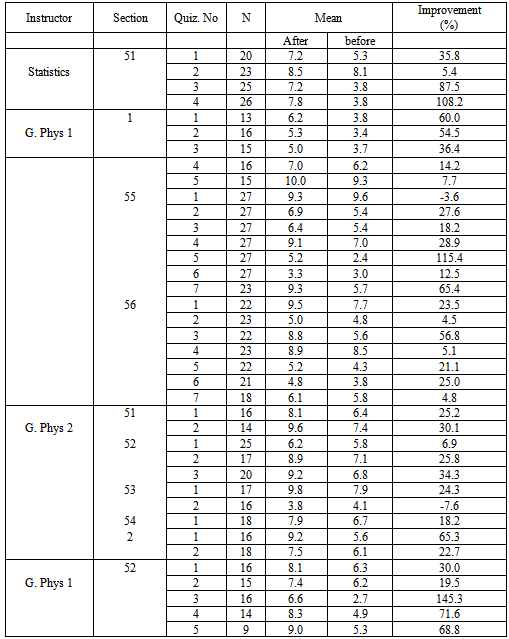 |
| |
|
The percent improvements ranged from 4.5% to 145.3%. The overall improvement rate for all tests is 39%. The decrease in some of the tests is due to the fact that these tests consisted of 2 multiple-choice questions and as one can guess the chance of missing the right answer is greater. Individual paired t-tests (and Wilcoxon signed-rank tests when the differences were not normally distributed) were used to see which of the above improvements were statistically significant. 52% turned out to be significant at the 1% level. The results are shown in Table 2.Table 2. Quizzes for different courses, sections, and instructors showing the paired t-test (Wilcoxon*) statistics and p-values for each quiz
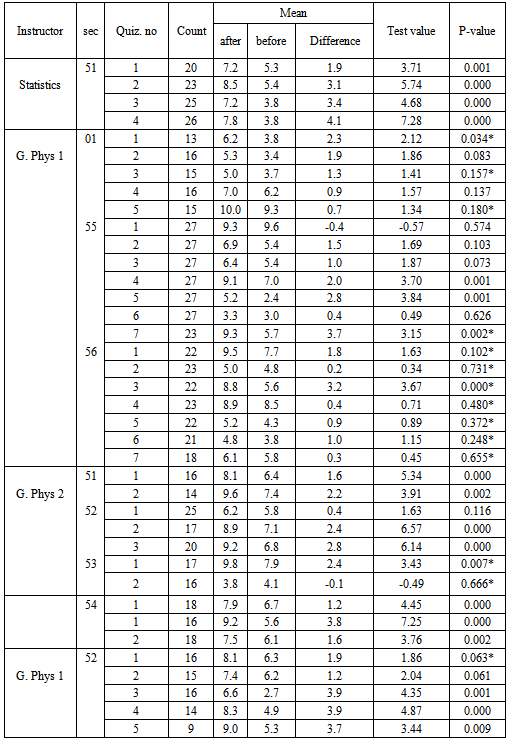 |
| |
|
As for the significance of the overall improvement, weighted averages, were computed before and after peer instruction, and a paired t-test was performed. The results are shown in table 3. The overall improvement turned out to be significant with a p-value of 0.0008. The McNemar test was used to determine whether there is any significant improvement in the rate of students passing the tests after peer instruction. Table 4 shows the percentages of pass and fail before and after PIMT. The results of the test show significant improvements in the test success rate with a p-value less than .0001. The overall pass rate went from 68.1% to 87.6%, while the fail rate went down from 31.9% to 12.4%. Table 3. Paired t-test for overall improvement
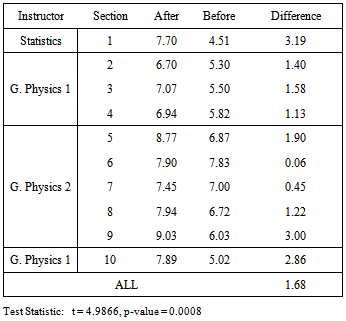 |
| |
|
Table 4. McNemar test for success rate improvement
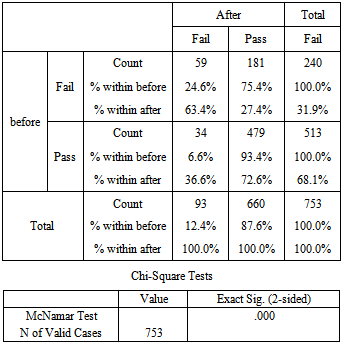 |
| |
|
Finally, to see whether the academic standing of students has anything to do with the effect of PIMT, we computed correlations between student cumulative GPA and the difference in average scores. The Pearson correlation coefficient was weak and valued at 0.27 as seen in Table 5, and even though the parallel box-plots in Figure 1 show an increasing trend in the average score differences as the GPA increases, the one-way ANOVA results in Table 6 shows the insignificance of that trend with a p-value of .083.Table 5. Correlation between GPA and PIMT results
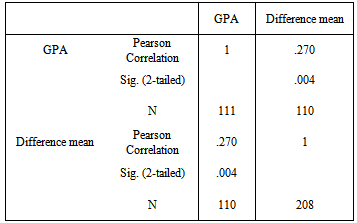 |
| |
|
Table 6. ANOVA on effect of GPA on PIMT results
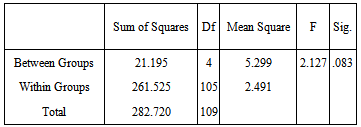 |
| |
|
Instructors who use traditional method of teaching, normally, skip peer discussion entirely, believing that instructor explanation of the correct reasoning will be more clear and accurate than an explanation by other students, and will therefore lead to more student learning. Although our current work does not directly compare the benefits of instructor versus peer explanation, research in physics has shown that instructor explanations often fail to produce gains in conceptual understanding[11]. The results of the present work shows that peer discussion can effectively promote such understanding. Furthermore, justifying an explanation to a fellow student and skeptically examining the explanation of a peer provide valuable opportunities for students to develop the communicative and metacognitive skills that are crucial components of disciplinary expertise.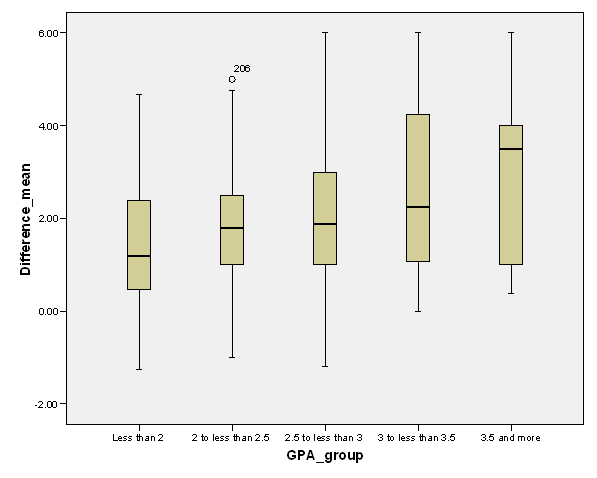 | Figure 1. Parallel Box-Plot Comparison of PIMT effect for different academic standings |
3. Conclusions
The results of PIMT experiments carried out in different introductory courses with different instructors showed a significant improving effect of this collaborative teaching method on the students’ understanding of concepts and their problem solving capabilities. It remains to be investigated how the PIMT affects the overall performance of the students in the common exams when compared to students who did not use this method.
ACKNOWLEDGEMENTS
This work was financially supported by the Research Affairs at the UAE University under a contract no. 05-02-2-11/07.
References
| [1] | Johnson, D.W., R.T. Johnson, and K.A. Smith, Cooperative Learning: Increasing College Faculty Instructional Productivity, ASHE-ERIC Higher Education Report No. 4, George Washington University, Washington, D.C., 1991. |
| [2] | Bonwell, C.C. and J.A. Eison, Active Learning: Creating Excitement in the Classroom, ASHE-ERIC Higher Education Report No. 1, George Washington University, Washington, D.C., 1991. |
| [3] | McKeachie, W.J., Teaching Tips: A Guidebook for the Beginning College Teacher, 9th Edn., D.C. Heath, Lexington, MA, 1994. |
| [4] | Prince, M. (2004) "Does Active Learning Work? A Review of the Research," Journal of Engineering Education, 93:3, 223-231 |
| [5] | Johnson, D.W., Johnson, R.T., and Smith, K. (1991) Active Learning: Cooperation in the College Classroom, Edina, MN: Interaction Book Company. |
| [6] | E. Mazur, (1997) Peer Instruction: A User's Manual, Prentice Hall Series in Educational Innovation, Upper Saddle River, NJ 07458. |
| [7] | M. Benkraouda: Using the peer instruction method in teaching general physics with Blackboard as a tool; in Stewart, S. M., Olearski, J. E. and Thompson, D. (Eds), Proceedings of the Second Annual Conference for Middle East Teachers of Science, Mathematics and Computing (pp. 157-160). METSMaC: Abu Dhabi (2006). |
| [8] | R. A. Serway and J. W. Jewett, Jr., (2004) Physics for Scientists and Engineers, Test Banks, Thomson Brooks/Cole, Belmont CA, 94002. |
| [9] | http://www.physics.umd.edu/perg/role/PIProbs/ProbSubjs.htm |
| [10] | A. P. Fagen, T. K. Yang, C. H. Crough, and E. Mazur (2000), Factors that make peer instruction work: A 700-user survey. Paper presented at the American Association of Physics Teachers, Winter Meeting, Kissimmee, FL. |
| [11] | D. Hestenes, Phys. Teach. 30, 141 (1992). |


 Abstract
Abstract Reference
Reference Full-Text PDF
Full-Text PDF Full-text HTML
Full-text HTML




